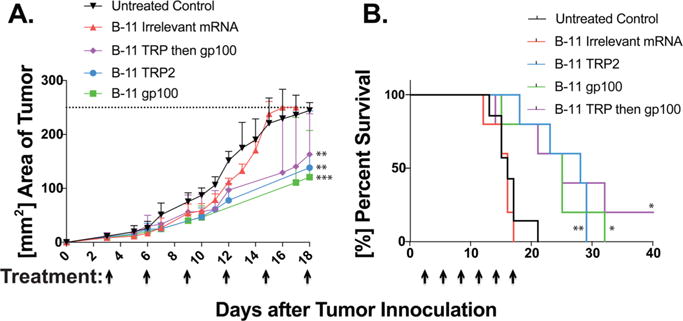Figure 4.

mRNA LNPs coding for tumor self-antigens, gp100 and TRP2, slow down tumor growth and extend overall survival. Mice (C57BL/6J, n = 7 for untreated control and n = 5 per other groups) were inoculated with 105 of B16F10 melanoma cells and treated began when tumors were visible in all mice on day 3. Treatment consisted of a subcutaneous injection of LNP formulation B-11 encapsulation the indicated mRNA (10 μg of total mRNA per mouse in 0.1 mL of sterile PBS). All of the treated mice receive six injections with 3-day intervals starting on day 3 after the tumor inoculation. The groups included six treatments with gp100, TRP2, irrelevant control mRNA, three treatments with TRP2 followed by three treatments with gp100, and an untreated control group. (A) Tumor areas were measured with a caliper lengths × width. Mice that reached the maximal allowed tumor area of 250 mm2, or that developed ulceration, were euthanized and recorded as having tumor areas of 250 mm2. All three treatment groups showed slower tumor growths (**P < 0.01, ***P < 0.001, as compared with either control group, two-way ANOVA with Bonferroni posthoc). (B) All three treated groups survived significantly longer the either the untreated control group or mice treated with irrelevant mRNA. One mouse in the group treated three times with TRP2 mRNA containing LNPs, followed by three treatments of gp100 mRNA containing LNPs, survived 60 days (the end of the study) without visible tumors. (*P < 0.05, **P < 0.01, as compared with the untreated control group, Mantel Cox test). LNPs containing mRNA coding for OVA were used as irrelevant controls to generate the figure.
